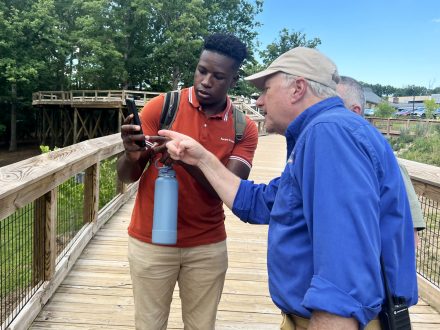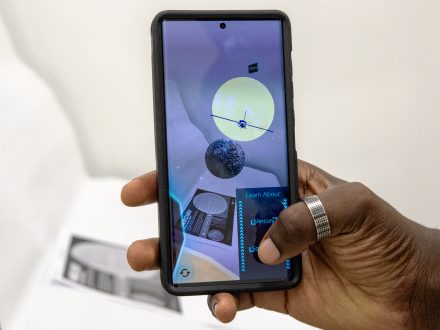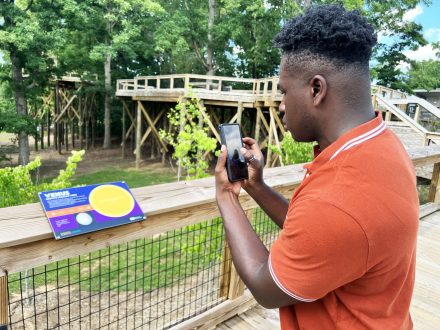Agyemang turned a newfound passion for game design and immersive technologies into an app that lets Greensboro Science Center visitors tour the solar system as part of its new Solar Hike exhibit.
The magic starts when Henry Agyemang ’24 holds his phone up to a small sign that says “Earth.”
In an instant, the familiar blue-green marble of our planet appears on his screen. The moon spins in its orbit. A satellite rushes by. As he rotates his phone in different directions, nearby planets appear on the horizon. One by one, Agyemang planet hops via his phone screen, pausing at Saturn’s vibrant rings and Jupiter’s massive moons to take in the sights.

Each vista is part of SolAR, the augmented-reality app Agyemang designed for the Greensboro Science Center’s new Solar Hike, which opens this summer and provides visitors with a walking tour of the solar system. The exhibit is built to scale as if the sun were the size of a soccer ball. At each planetary stop, users will access the app for information about the planets and view Agyemang’s animated models. The app helps the Greensboro Science Center meet its mission of providing guests with a rich, interactive experience connected to exhibits.
“Henry produced these three-dimensional models: You can look around them, over and under them, you can see the spacecraft orbiting around them and see them in relation to other planets in the solar system,” said Ron Settle, the center’s vice president of innovative technology and interpretation. “The opportunity to have an Elon student create this and to incorporate it with other augmented-reality experiences we’ve developed was a great gift to us. It’s a fresh and novel way to bring science to life.”
Agyemang — an engineering major with a computer engineering concentration from Charlotte, — completed the SolAR app through the Summer Undergraduate Research Experience in 2023 with the mentorship of Assistant Professor of Computer Science Pratheep Paranthaman. They fine-tuned it into the fall and presented it to museum staff in October. In February, he traveled to London to present his app and research into augmented and virtual realities at the Ninth International Congress on Information and Communication Technology (ICICT 2024).

Working on the project, Agyemang discovered a passion for and curiosity around augmented and virtual reality technologies. Augmented reality uses a real-world setting and devices like your phone to superimpose objects you can interact with on the screen, like the game “Pokémon Go.” Virtual reality relies on devices like headsets to create an immersive, virtual world around the user.
Agyemang has applied to graduate programs in computer science and plans to pursue a doctorate to continue researching users’ experiences with the technologies.
“This was the first time I’d worked with augmented reality, and without this project, I wouldn’t have known that this is what I want to continue researching in a Ph.D. program and in my career,” he said.
Agyemang initially planned an engineering career, but — a common tale at Elon — one elective changed his trajectory. In his sophomore year, he enrolled in the GAM 2100 Game Design course taught by Paranthaman, who is coordinator of Elon’s Game Design minor. Agyemang was taken with the field and completed the minor, including collaborating with a team of students to create and publish the game, “Samira: Taken From Time,” in its capstone courses.

The Greensboro Science Center project resulted from existing connections to Elon. Lindsey Zarecky, the center’s vice president of conservation and research, has collaborated with Associate Professor of Statistics Nicholas Bussberg on several projects. She and the center welcome additional collaboration with Elon faculty and students, and when Paranthaman approached to inquire about opportunities in game design and gamification, his areas of expertise, the Solar Hike was identified as an opportunity.
Paranthaman says Agyemang’s success in the project stems from his perseverance and positivity. “He was willing to explore and was able to view challenges as opportunities,” Paranthaman said. “He investigated problems and learned from them, essential traits that any researcher should have in an immersive technology project. How do you take all these tools and use game design to present information in an engaging way? That was the biggest challenge Henry addressed through this project.”
Paranthaman’s mentorship in courses and in the Solar Hike project led Agyemang to new paths of inquiry and confidence in his abilities.

“Knowing how challenging and time-consuming game design is, having Dr. Paranthaman there guiding me was very motivating. He would stop everything and come to the lab, even at 10 p.m. one night, to help me work through a problem,” Agyemang said.
“What I learned in this project goes further than what I could have learned in a class,” Agyemang said. “I learned I am capable of doing this work, and I have a product that shows that I’m capable. That gives me more confidence going into the field.”



